Kinetic wind generator: device, principle of operation, application
A modern kinetic wind generator allows you to use the power of air currents, converting it into electricity. For this purpose, there are factory and home-made models of devices that are used both in industry and in private farms.
We will talk about how windmills of this type are arranged, we will introduce you to the features of the device and design options. The article we have proposed shows the strengths and weaknesses of a wind power plant. Independent masters with us will find useful schemes and recommendations for assembly.
The content of the article:
The principle of operation of a wind generator
The operation of the wind generator is based on the transformation of the kinetic energy of the wind into the mechanical energy of the rotor, which is then converted into electricity.
The principle of operation is quite simple: the rotation of the blades mounted on the axis of the device leads to circular movements of the rotor generator, due to which electricity is generated.

The resulting unstable alternating current "flows" into the controller, where it is converted to a constant voltage that can charge the batteries. From there, the power is supplied to the inverter, where it is transformed into alternating voltage with an indicator of 220/380 V, which is supplied to consumers.
The power of the wind generator directly depends on the power of the air flow (N), calculated according to the formula N = pSV3/ 2, where V is the wind speed, S is the working area, p is the air density.
Wind generator device
Different versions of wind generators are significantly different from each other.
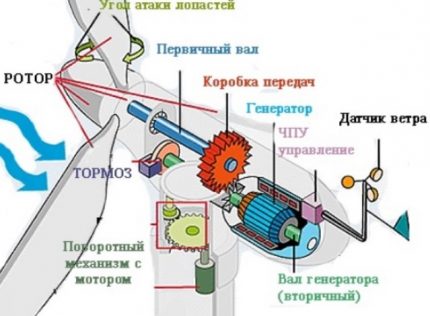
Industrial devices are a complex multi-meter construction, the installation of which requires a foundation, while a household model can consist of a minimum of components (3-12V DC motor, 1000uF 6V electrocapacitor, silicon rectifier diode).
A typical installation includes the following components:
- alternator (power depends on the speed of wind flows);
- blades that transmit rotation to the generator shaft (often they are additionally equipped with gearboxes, rotor speed stabilizers);
- mast of the windmill, to which the blades are attached (the higher these elements are, the greater the amount of wind energy they can receive);
- batteries that accumulate energy, which allows you to use it with a small wind flow or its complete absence. The battery also performs the function of stabilizing the electrical energy received from the generator;
- controller - a converter of alternating voltage received from the generator into direct current, which is used to charge the battery. The controller is controlled by turning the blades, which allows you to consider where the air flows;
- ABP - automatic switching device that connects the wind generator with other sources of energy (solar panels, power grid);
- wind direction sensor - a device that makes it easier for the blades to find the wind flow;
- an inverter for converting direct current from batteries to alternating voltage, which is used in electrical communications.
To better meet user needs, the device can be equipped with various types of inverters:
- devices with an inverter-modified sine wave, issuing a square sinusoid. Devices of this type are suitable for heating elements, incandescent lamps and other devices that are undemanding to the quality of the network;
- three-phase voltage inverters designed for three-phase power networks;
- pure sine wave installations that produce energy for a more sensitive technique;
- network inverters capable of functioning without batteries. Such devices are intended for circuits involving the ingress of electrical energy directly into a common network.
When choosing models, you should definitely pay attention to the type of inverter.
Types of Wind Generators
When classifying wind turbines, characteristics such as:
- appointment;
- design features;
- number of blades;
- the materials from which they are made;
- axis of rotation;
- screw pitch.
Consider in detail the two most commonly used classifications.
Classification of wind generators by purpose
There are varieties of wind turbines that differ in purpose. The main characteristics of the devices, for example, power, depend on this.
Industrial wind turbines
Such devices are installed by large energy companies or by the state to supply electricity to industrial facilities. Turbines with a capacity of tens of megawatts are usually located in wind areas (open hills, coasts).
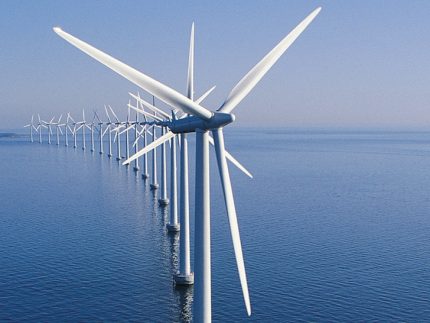
The generated electricity, as a rule, goes directly to the network, while for stability and regulation of the frequency of rotation of the blades of the wind turbine are equipped with additional mechanisms.
Commercial wind generators
Such installations are used to generate electricity for sale or to provide electricity to industries in regions with low-power networks (or with its complete absence). Such wind farms consist of a cluster of electric generators, which can have different capacities.
The energy of commercial plants can be supplied directly to electrical communications or used to charge a large array of batteries, where it is stored and converted for supply to the power system.
Household Wind Devices
Low power units are used for private use. According to the rules, windmills with masts with a height of less than 25 meters can be installed by the owners of the sites without the consent of the authorities, for higher masts it is necessary to obtain special permission.
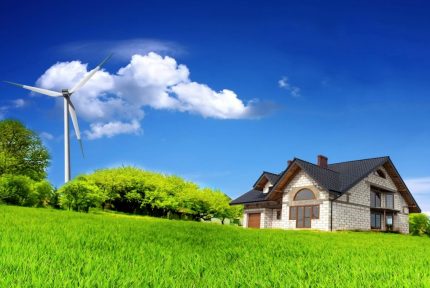
Household wind generators are suitable for charging batteries with a voltage of 12/24 / 48V, the energy from which is transformed into a voltage of 220 volts. Such devices can completely or partially solve the problem with the power supply of small objects that are located away from the centralized power grid.
With guidelines for choosing a wind generator to provide energy to a private home will introduce the articlededicated to this interesting question.
Varieties of construction of windmills
According to the design features of the device can also be divided into a number of categories, although all varieties are reduced to two main types: vertical and horizontal.
Classic horizontal wind generators
Similar installations (they are also called propeller or vane) usually have 3-5 blades mounted on a horizontal axis. Rotating at high speed, such elements allow you to get the maximum amount of energy (KIEV up to 0.4).
Moreover, the amount of electricity generated largely depends on the height of the device (the higher it is, the greater the result).

Such devices are usually installed in wind farms where energy is generated for industrial and commercial use, but they are also suitable for domestic use.
An interesting solution to a horizontal windmill is a model with one blade, its features will be introduced by the following selection of photos:
Vertical wind turbines
An active element of such installations is a rotating wind wheel. Due to the design features, such designs differ in type (“Barrel”, “Savonius”).
The following photo selection will familiarize you with the principle of building a turbine for a vertical Savonius generator:
Despite the low KIEV index (0.1-0.2), they are widely used: vertical units operate on turbulent air flows, so they can be placed even in areas where strong winds rarely blow.
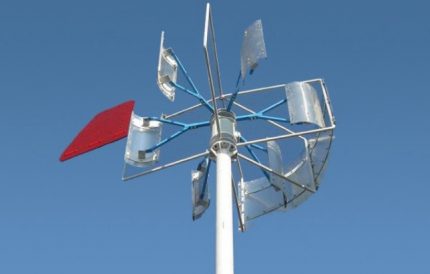
To increase the efficiency of vertical windmills, manufacturers often increase their size parameters, which leads to a significant increase in cost. Since such installations are fragile enough, they require increased protection against hurricanes and other natural phenomena.
Wind Generators "Rotor Daria"
Such devices belong to the category of vertical wind turbines, however, they have pronounced differences in design. Thanks to these features, noise reduction is achieved, and KIEV grows, which approaches the performance of horizontal models.
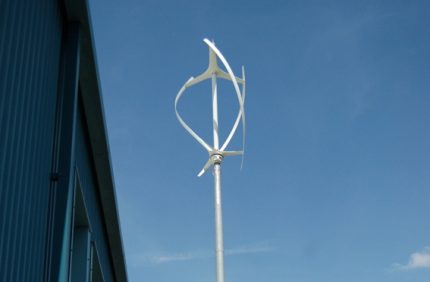
The disadvantage of such designs is the low starting moment (due to the presence of only two blades, it is difficult for the device to start independently). To solve the problem, the Savonius + Darier hybrid is often used.
Sailing Wind Installations
For such installations, the principle of both vertical and horizontal windmills can be applied. The main structural feature is a wind wheel covered with many blades or sails, while the aerodynamic profile of such models is absent.

Despite the fact that sailing installations are characterized by low-speed and low efficiency, they are often used in the national economy. Such designs are easy to install and operate, and the combination of high torque with low speeds allows you to directly set in motion various useful mechanisms, for example, a pump for pumping water.
The following gallery will familiarize you with one of the practical models of sailing windmills:
Wind turbine generator
For the operation of windmills, conventional three-phase generators are needed. The design of such devices is similar to the models used on cars, but has large parameters.
In devices for wind turbines, a three-phase stator winding (star connection) is provided, from where three wires go to the controller, where the alternating voltage is transformed into direct voltage.

To increase the speed, a multiplier is often used. This device allows you to increase the power of the existing generator or use a smaller device, which reduces the cost of installation.
Multipliers are more often used in vertical wind generators, in which the process of rotation of the wind wheel is slower. For horizontal devices with a high speed of rotation of the blades, multipliers are not required, which simplifies and reduces the cost of construction.
The specifics of the assembly and installation of a wind generator from the washing machine and wind turbines from a car generator detailed in our recommended articles.
Pros and cons of a wind generator
Let us consider in detail the advantages and disadvantages of wind turbines, since the decision to purchase a windmill or abandon it depends on them.
Advantages of wind devices
The benefits of wind energy devices include:
- Environmental friendliness. The plants use a renewable energy source, which can be used continuously without harming the environment. Electricity generated by wind generators replaces the energy of thermal power plants, reducing greenhouse gas emissions.
- Versatility. Wind farms can be built almost everywhere: on the plains, in the mountains, in the fields, on the islands and even in shallow water. Wind energy is especially appreciated in remote places where it is difficult to extend the usual electrical communications. In this case, wind generators make it possible to establish power supply to facilities, providing it with independence from random factors (for example, from fuel not delivered on time).
- Use efficiency. Modern models recycle the energy of even light winds - the minimum limit is 3.5 m / s. In this way, it is possible to supply electricity to a centralized network, as well as organize the power supply of individual facilities (island or local), regardless of their capacity.
- A worthy alternative to traditional sources. Stationary wind farms can fully provide electricity to a residential building or even a small production facility. In this case, the turbine will accumulate in the batteries the required supply of electricity, intended for use during windless periods.
- Profitability. Compared to traditional sources of electric energy (gas, peat, coal, oil), bicycle turbines can significantly reduce energy costs. In many cases, building a wind farm is cheaper than connecting to existing power systems.
The use of wind turbines can be an alternative to the use of expensive diesel generators, further reducing the cost of transportation and storage of fuel up to 80%.
The average power of a wind turbine differs significantly from the peak load indicator. A wind generator is only responsible for the amount of energy produced for a certain period of time with the average monthly wind speed characteristic of a given area.
For a more accurate assessment of wind resources, you can use specially derived data (Weibull parameters). These indicators reflect the distribution of winds of different strengths characteristic of a particular area. Such information is important to consider when developing wind farm projects with a capacity of tens of MW.
The power generated by the wind turbine is proportional to the triple wind speed. Therefore, this indicator is very small with weak wind currents, however, when they are strengthened, it increases sharply. Due to the variability of the direction of the winds and their speed during the construction of the wind turbine, it is necessary to provide stabilizing components.
Rules and formulas for calculating the power of a wind generator given hereWe recommend that you read some very useful information.
In small autonomous systems, their function is performed by batteries, the charge of which begins to increase as soon as the power of the wind generator exceeds the load indicator.
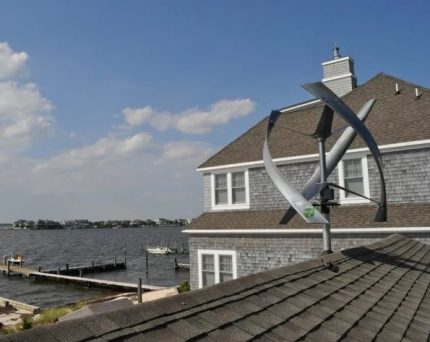
It should be noted that the effective use of wind flows contributes to the variety of designs of wind generators.
Horizontal turbines give high performance in flat places where there are many winds, while vertical turbines work better in regions with turbulent flows that are observed low from the ground (in the upper part of hills, mountain ranges).
The main disadvantages of windmills
At the same time, windmills have their own negative aspects:
- The magnitude of the wind force is difficult to predict in advance, since it often changes. Because of this, it is advisable to think over a safety net, providing for a backup energy source (solar panels, electrical connection).
- Vertical devices are at risk of destruction of the rotor blades due to the action of centrifugal forces when the blades rotate around the main axis. Due to this effect, important structural elements become deformed and destroyed over time, and the mechanism fails.
- Windmills are best installed in free space, since nearby buildings can "damp" the wind, forming a "dead" air zone.
- To save the excess energy of wind turbines, it is necessary to provide for the use of batteries and other additional devices in the design, which are used to convert the generated electricity to current with suitable consumer characteristics.
- During operation, wind generators make a noise that can cause discomfort to people, scare away animals. The blades of the installations can also cause the death of birds flying up to them.
- According to some experts, wind turbines can degrade the reception of radio and television broadcasts.
The negative aspects can also include the rather high cost of such units, however, the cheapness of the energy source largely eliminates this factor.
Schemes and connection methods
Although the wind turbine can operate autonomously, a much better result can be achieved with the help of combined schemes that provide for the combination of a wind device with solar panels, a centralized electric grid, diesel or gas energy sources.
Offline work. In this case, a single installation is set, with the help of which wind energy is captured and accumulated, which is then converted into an electric current that consumers need.
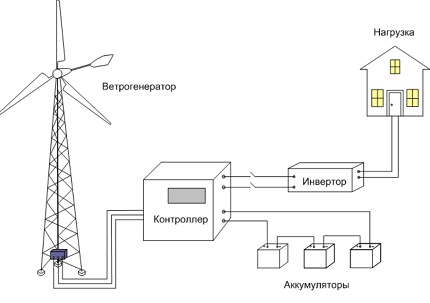
Combining a wind generator with solar panels. The combined option is considered a reliable and efficient way of power supply. In the absence of wind, the battery runs on solar panels, and in cloudy weather and during the night, charging comes from a wind installation.
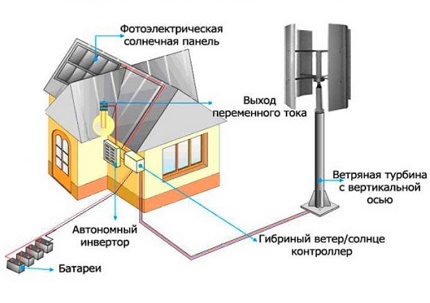
Combined wind generator and mains operation. A wind turbine can be combined with electrical communications.
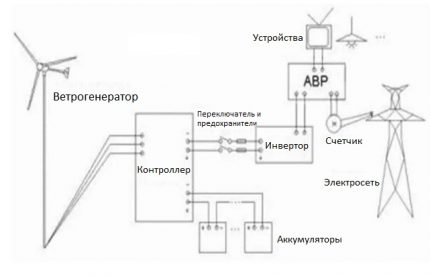
With excess electricity produced, it enters the centralized network, and with its shortage, it is possible to use electric current from the general power system.
Nuances of using wind generators
Currently, wind turbines are used in various sectors of the economy. Industrial models of different capacities are used by oil and gas, telecommunications companies, drilling and exploration stations, production facilities and government agencies.

Of particular note is the importance of using wind turbines for the rapid recovery of disrupted electricity during cataclysms and natural disasters. To this end, wind generators are often used by the Ministry of Emergencies.
Household wind turbines are perfect for organizing lighting and heating of cottage villages and private houses, as well as for household purposes on farms.
In this case, some points should be taken into account:
- Devices up to 1 kW can provide a sufficient amount of electricity only in windy places. Usually the energy they produce is enough only for LED lighting and power for small electronic devices.
- To fully provide electricity to the cottage (country house) you will need a wind generator with a capacity of more than 1 kW.This indicator is enough to power the lighting, as well as a computer and TV, but its power is not enough to provide electricity to a modern round-the-clock refrigerator.
- To provide the cottage with energy, you need a 3-5 kW windmill, but even this figure is not enough for heating houses. To use this feature, you need a powerful option, starting from 10 kW.
When choosing a model, it should be noted that the power indicator indicated on the device is achieved only at maximum wind speed. So, a 300V installation will produce the indicated amount of energy only at an air flow rate of 10-12 m / s.
Those who wish to build a wind generator with their own hands, we offer next articlein which useful information is detailed.
Conclusions and useful video on the topic
The video below provides detailed information on the principle of operation and the design of a household model of a wind generator:
A wind generator is an excellent source of electric energy production, which residents of remote places will especially appreciate. Various Russian and foreign enterprises offer a wide range of wind structures, in addition, household models can be made with your own hands.
Please write comments in the block below. Tell us about how you built a wind generator on your site, or how your neighbors have a windmill. Ask questions, share useful information and photos on the topic.

 How to make a wind generator with your own hands: device, principle of operation + best home-made
How to make a wind generator with your own hands: device, principle of operation + best home-made 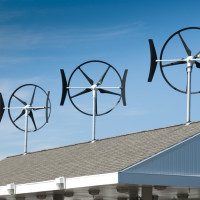 Wind generator for a private house: device, types, overview of the best offers
Wind generator for a private house: device, types, overview of the best offers  How to make a controller for a wind generator with your own hands: device, principle of operation, assembly diagram
How to make a controller for a wind generator with your own hands: device, principle of operation, assembly diagram 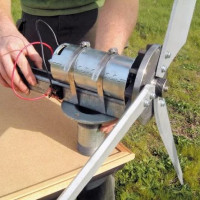 Do-it-yourself wind generator from a washing machine: assembly instructions for a windmill
Do-it-yourself wind generator from a washing machine: assembly instructions for a windmill 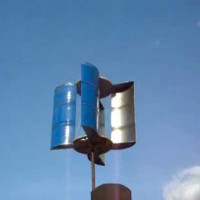 DIY wind generator from a car generator: windmill assembly technology and error analysis
DIY wind generator from a car generator: windmill assembly technology and error analysis  Do-it-yourself vertical wind generator: how to assemble a wind turbine with a vertical axis of rotation
Do-it-yourself vertical wind generator: how to assemble a wind turbine with a vertical axis of rotation  How much does it cost to connect gas to a private house: the price of organizing gas supply
How much does it cost to connect gas to a private house: the price of organizing gas supply  The best washing machines with dryer: model rating and customer tips
The best washing machines with dryer: model rating and customer tips  What is the color temperature of light and the nuances of choosing the temperature of the lamps to suit your needs
What is the color temperature of light and the nuances of choosing the temperature of the lamps to suit your needs  Replacement of a geyser in an apartment: replacement paperwork + basic norms and requirements
Replacement of a geyser in an apartment: replacement paperwork + basic norms and requirements
Are there companies in Moscow or the region selling and installing similar windmills with a height of less than 25 meters in the territories of private citizens? I would have installed in my cottage, just how many of them are needed, several or one? It is necessary to calculate how much all the work will cost. Which is better - vertical or sailing, or horizontal? We have a particularly windy place in the wasteland - it blows a lot all year round!
It may be that wind generators are suitable for industrial use, but the fact itself is that there should be a lot of wind turbines for a household system, not to mention an industrial one, this time. And two - they are very expensive. Even solar panels are cheaper and more economical to install than a wind turbine. However, coming from time to time to Germany and Holland, you see huge areas with wind turbines. I don’t know how effective they are. But I know that in modern houses for themselves practical Germans, if they install ecological sources of electricity, then I have never seen solar panels or windmills anywhere.
“The resulting unstable alternating current“ flows ”into the controller, where it is converted to a constant voltage ...” Brilliant! Current is converted to voltage))